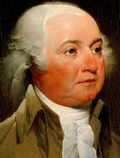 |
John Adams
b. 19/30 Oct 1735, Braintree (now Quincy), Norfolk County, Massachusetts [1]
d. 4 Jul 1826, Braintree (now Quincy), Norfolk County, Massachusetts |
| Title: |
President of the United States |
| Term: |
4 Mar 1797 - 4 Mar 1801 |
| Chronology: |
8 Feb 1797,
the election to the office of the President of the United States is declared upon the ascertainment and counting of the electoral vote (cast 7 Dec 1796), joint session of the Senate and House of Representatives, House of Representatives Chamber, Congress Hall, Philadelphia [2] |
|
4 Mar 1797,
commencement of term |
|
4 Mar 1797,
took the oath of office as the President of the United States, inaugural ceremony as part of the special session of the Senate, House of Representatives Chamber, Congress Hall, Philadelphia [3] |
|
4 Mar 1801,
expiration of term |
| Biography: |
| Son of John Adams, a farmer and deacon in the Congregational Church; was baptised by the Rev. John Hancock, father of John Hancock; studied in Harvard College (1751-1755); studied the law and taught school at Worcester; was admitted to the bar of Suffolk County (1758); became a member of the Sons of Liberty and opposed the Stamp Act; removed to Boston (1768), where he won distinction at the bar; was chosen a representative from Boston in the legislature of Massachusetts (1770); a member of the Continental Congress (1774, 1775-1778); was the adviser and great supporter of the Declaration of Independence (1776); nominated a deputy to treat with Lord Howe for the pacification of the Colonies; declined the offer of chief justice of Massachusetts; served as a member of the Board of War, but resigned to accept an appointment (28 Nov 1777) as a commissioner to the Court of France; returned home in the summer of 1779; was elected a member of the Massachusetts convention for framing a State constitution; appointed by Congress minister plenipotentiary (29 Sep 1779) to negotiate a peace treaty with Great Britain; was a commissioner to conclude treaties of peace with European powers (1781); served as minister plenipotentiary to the Netherlands (1782); negotiated with others a commercial treaty with Great Britain (1783); was one of the commissioners to sign the provisional treaty of peace with Great Britain (30 Nov 1782), and the definite treaty (3 Sep 1783); was appointed minister at the Court of Great Britain (1785-1788); returned to his home in 1788; was elected Vice-President of the United States (21 Apr 1789 - 4 Mar 1797) on the ticket with George Washington; entered upon his duties in the Senate 21 Apr 1789 and took an oath to support and defend the Constitution 3 Jun 1789 (oath of office for Vice President being not required); was reelected Vice-President in 1792; on the retirement of Washington in 1796, he was elected President of the United States (4 Mar 1797 - 4 Mar 1801); formed an administration, mostly composed of the past cabinet members; faced a crisis of relations with France; proposed (1798) the creation of a navy department; signed into law the Alien and Sedition Acts (1798), which imposed restrictions on aliens suspected of pro-French activities and penalties on those who criticized the government; became the first chief executive to take residence in the White House, Washington, D.C. (1800); as a result of the bitter split within the ruling party, he was defeated for reelection (1800); retired to his home at Quincy, Massachusetts (1801); was elected to head the list of Presidential electors of his party in the State (1816); was a member of the State convention to revise the constitution of Massachusetts (1820); was unanimously elected president of that convention, but declined it on account of his age. |
| Biographical sources: Biographical Directory of the United States Congress (2005); Compilation of the Messages and Papers of the Presidents (1903), vol. 1; Village Register, Vol. VII, No. 38, Dedham (Mass.) Thursday Evening, July 6, 1826, p. 3, col. 2 (obituary). |
| Elections: |
| Candidate |
Electoral vote (7 Dec 1796) |
| John Adams |
71 |
| Thomas Jefferson |
68 |
| Thomas Pinckney |
59 |
| Aaron Burr |
30 |
| Samuel Adams |
15 |
| Oliver Ellsworth |
11 |
| George Clinton |
7 |
| John Jay |
5 |
| James Iredell |
3 |
| Samuel Johnston |
2 |
| George Washington |
2 |
| John Henry |
2 |
| Charles Cotesworth Pinkney |
1 |
| total number of electors appointed |
138 |
| number of votes for a majority |
70 |
|
| Source of electoral results: Senate Journal, 4th Congress, 2nd Session, 320; Annals of Congress, Senate, 4th Congress, 2nd Session, 1543-1544. |
| |
| [1] |
"Records of the Town of Braintree : 1640 to 1793", ed. by Samuel A. Bates (Randolph, Mass.: Daniel H. Huxford, 1886, web site), p. 772: "[202] <...> John Adams the son of John Adams and Susanna his wife born October 19th. 1735." |
| [2] |
Senate Journal, 4th Congress, 2nd Session, 320-321; Annals of Congress, Senate, 4th Congress, 2nd Session, 1542-1544. |
| [3] |
Senate Journal, 5th Congress, 1st Session, Appendix, 397-401; Senate Executive Journal, Volume 1, 233-239; Annals of Congress, Senate, 4th Congress, 2nd Session, 1580-1586; Gazette of the United States, & Philadelphia Daily Advertiser, Volume XI, Number 1401, Monday Evening, March 6, 1797. |
| |
Image: portrait by John Trumbull, 1793. |

